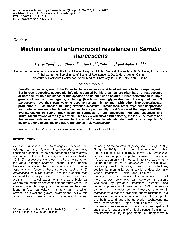摘要
Serratia marcescens, one of the Enterobacteriaceae, was considered originally to be non-pathogenic. But in recent decades, nosocomial infections caused by this organism are often hard to treat because of both the intrinsic resistance of this species and its abilities to acquire further resistance to multiple groups of antimicrobial agents, including beta-lactams, aminoglycosides and fluoroquinolones. S. marcescens have their own ways to become resistant in common with other Enterobacteriaceae: production of beta-lactamases including extended-spectrum beta-lactamases, AmpC-type cephalosporinase and carbapenemases; diminished outer membrane permeability; modification of the target site-PBPs; overexpression of active efflux systems; synthesis of aminoglycoside-modifying enzymes; and structural alterations of the GyrA protein. This review will show a brief history, the virulence factors and the known resistance mechanisms to the most frequently administrated antimicrobial agents: beta-lactams, aminoglycosides and fluoroquinolones in S. marcescens.
- 出版日期2012-6-9
- 单位安徽医科大学
